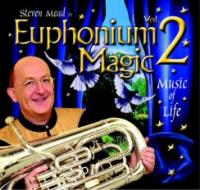Euphonium Magic Vol. 2 review by Peter Bale
Review from www.4barsrest.com by Peter Bale - Euphonium Magic Vol.2
Is it possible to have too much of a good thing? Well, as filmmaker Morgan Spurlock demonstrated in his film "Supersize Me", a diet without sufficient variety will not only be quite unhealthy, but will also prove very monotonous.
There is no such risk in this, the second volume of Steven Mead's series of multi-tracked recordings, as there is a wide range of both musical and playing styles, with something that should appeal to everybody. In these days of sophisticated music technology, when composers such as George Benjamin are able to sample instrumental sounds and then reproduce music that could not possibly be played on the original instruments, it is sometimes hard to know exactly what you are listening to: here one simply marvels at the technique and stamina involved as multiple Steven Meads make sophisticated music together. Undoubtedly there is an art to producing a multi-tracked recording - many will know how difficult it is to play with an accompaniment tape, never mind synchronising more than a dozen parts - but Steven is definitely a master of the art, producing readings of subtlety and musicality throughout.
The opening track, Danny Elfman's "What's This?" , taken from the movie "Nightmare before Christmas", sets the tone for what is to follow. It is a lively, approachable piece, with the six parts incorporating some busy accompanying lines.
The next two tracks have been arranged by Maurice Bale, and here your reviewer must declare an interest, having known Maurice all his life! The "Finale from Beethoven's Fifth Symphony" was arranged to be played as a massed item at a recent tuba conference, and is scored for 6 euphoniums, 3 EEb basses and 2 BBb basses, with additional, more straightforward, parts
so that players of varying abilities could take part. Steven shows his customary precision, not least in the ascending runs which marked the first appearance of the piccolo in a symphony. Chopin's "Waltz Op 64 no 2" is in total contrast - only four parts, but calling for a very delicate treatment and flexibility in the phrasing. It also shows Steven's control in the uppermost range of the instrument, with the melody and accompaniment subtly blending together.
The "Processional to the Minster" from Wagner's "Lohengrin" has been arranged for various musical forces, including a couple of fine versions for band. Again, there is some fine playing, although the occasional switch of octave takes one unawares at first, and one misses the depth and fulness of sound that a full band would bring. The arrangement is by Japanese euphonium player Akihito Ito, winner of the third prize at the ITEC Euphonium Artist competition in Budapest.
Next comes one of the highlights of the recording, a quartet by Yasuhide Ito, entitles "Euphoniums Parfait". The composer, a noted pianist and band composer, has provided a four movement suite in a range of styles, that is sweet but certainly not sickly! Warm playing, the judicious use of rubato, and a particularly effective jazz waltz in "Gelato con Cafe" that maintains its rhythmic feel beautifully despite the absence of a rhythm section.
Although best known for his miniatures Grieg's writing always sounds well on brass, particularly in his more solemn moments, such as the "Homage March". Emily Harris has set "Ase's Death (from Peer Gynt)" for six euphoniums, and the music progresses relentlessly onward, using the full range of the instrument, including some telling pedal notes.
American euphoniumist and teacher Gail Robertson, who was also responsible for the opening number, provides an affectionate version of "When you wish upon a Star" , opening with a low unison then blossoming out as the parts diverge. Not such a stunning version, maybe, as the solo version he's performed previously, but with some pleasant close harmony work in places.
"Take Five" will always be associated with Dave Brubeck and the silky saxophone tones of Paul Desmond, but the flowing line adapts well to euphonium, divided between the parts at times. A version of "Shenandoah" follows, originally intended for 9 trumpets but equally effective an octave down: the relatively narrow range emphasises the closeness of the
harmonies.
Due to its popularity with both children and adults, the theme for the cartoon series "The Simpsons" is probably instantly recognisable by most people: complete with dashing runs and siren effects there is nothing mechanical about the playing, but a real sense of colleagues combining together in performance.
Duke Ellington's "Come Sunday" , courtesy of Mnozil Brass, calls for a much more laid-back approach, making for a moment of calm before the eastern european rhythms of Thomas Dos's "A la Romanese", marked by very slick runs, double tonguing and falls off the notes.
Another original work comes from the pen of Danish composer/trombonist Morgens Andresen. "And soon it will be blossom time" is a reflective quartet, moving out from unison into rich harmonies, with the lush sound at times making it feel as if there are more than four parts on the go.
Music originally for bassoon often works well on euphonium, and the "Entrance and Polka of the Euphonium Player" exhibits no little humour, not least when the euphonium disappears into the stratosphere! This leads to the final item, described in the sleeve notes as "a joyous version of the famous Rosamunde" (aka the "Beer Barrel Polka" ), which features not only eleven euphoniums, but also a chorus of vocal Steven Meads - don't give up the day job, Steve!
Listening to this recording, one may start off by marvelling at the technical feat involved, laying down each track and synchronising the parts, but very quickly the music takes over and one simply wonders at the skill and musicianship of a player in top form. Although the running time is relatively short, that is understandable, given the amount of work involved: it is a most enjoyable disc, and will bring great enjoyment.
Peter Bale from www.4barsrest.com

Steven's sensational 2nd multi-track CD

